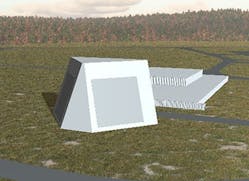The United States Missile Defense Agency (MDA) recently awarded Lockheed Martin a contract to build the new long-range discrimination radar (LRDR), a vital component of the United States’ ballistic missile defense (BMD) architecture. The radar system will be constructed on an “aggressive” deadline, according to an official statement from the company, with operational testing scheduled for the end of 2020.
The ground-based LRDR system will operate over the S-band, using solid-state gallium-nitride (GaN) active electronically-scanned antennas. Several MDA officials have referred to the LRDR as the “crown jewel” of the Ground-Based Midcourse Defense (GMD) system in California and Alaska. The LRDR will be capable of sensing and tracking missiles from extreme distances, enabling separate defense systems to intercept them.
The LRDR system is expected to be deployed at Clear Air Force Base in Alaska. The contract provides approximately $784 million in funding for the project. The system will be constructed at Lockheed Martin’s BMD development site in Moorestown, N.J. as well as other locations in Alaska, Alabama, Florida, and New York.
The LRDR project was proposed by the Department of Defense (DoD) in June. “The new LRDR will serve as a midcourse sensor to improve target discrimination capability for our BMD system to better address potential countermeasures and increase the capacity of the GMD inventory of interceptors,” the Pentagon said in an official statement about the project.
The new system will provide a long-awaited upgrade to the GMD system, which has been widely criticized for its poor discrimination capabilities. “The United States has a limited number of ground-based interceptors to detect threats, and the number of potential missile threats—and countermeasures used to hide those threats—is growing,” says Carl Banner, vice president of Lockheed Martin’s Integrated Warfare Systems and Sensors division, in an official statement from Lockheed Martin.
The primary sensor infrastructure of the GMD system was originally built for early warning purposes, according to George Lewis, a visiting scholar of Peace and Conflict Studies at Cornell University, in a blog post about the LRDR announcement. These radars have a relatively low operating frequency—about 440 MHz—limiting their bandwidth and resolution. According to Lewis, the low resolution of the radars prevents them from discriminating between warheads and relatively unsophisticated decoys. Operating in the S-band frequency range of 2 GHz to 4 GHz, however, the LRDR system will have the resolution necessary to discriminate these objects and make a more intelligent response to missile attacks.
The limitations of the current GMD system have made the LRDR a major priority for missile defense officials. “The LRDR is critically important to where I see the threat from North Korea going in the near future, with the capability of becoming more complex, requiring more interceptors,” James D. Syring, the director of the MDA, told Alaska Public Media in March.
Lockheed Martin is applying its experience with other missile defense programs to the LRDR system, according to Brad Hicks, vice president of business development Lockheed Martin, in an article from Defense News. The company has worked on the Aegis and Aegis Ashore ballistic missile defense systems and Aegis Ashore ground stations, as well as the Terminal High Altitude Air Defense (THAAD) system. More recently, Lockheed Martin has been working on the Air Force’s Space Fence program, a space surveillance system scheduled to become operational in 2019.
Raytheon Corp. and Northrop Grumman also made bids on the LRDR system. Raytheon has developed GaN-based active electronically scanned arrays (AESAs) to upgrade the Patriot Air and Missile Defense System, and cited the work with this technology in its proposal. Lockheed Martin will continue its work on the LRDR system until early 2024.

